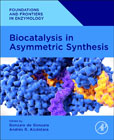
Biocatalysis in Asymmetric Synthesis, a new volume in the Foundations and Frontiers of Enzymology series, offers an applied discussion on synthesizing biological catalysts using asymmetric synthesis for varying applications. Here, global experts in the field analyze a wide variety of biocatalysts and their physical states, process conditions for their asymmetric synthesis, solvents required during synthesis, and even downstream procedures for the recovery of final products. The book adopts an interdisciplinary approach, merging fundamental biology and its synthetic applications across industries with a wide range of practical examples, from directed evolution to biotransformation and production of novel enzymes and non-conventional catalysts. Throughout the book, the impact and application of biocatalysis in sustainable processing is considered in-depth. This book will also help non-experts in biocatalysis to apply this knowledge in their own research, providing a thorough overview of the ways asymmetric biocatalytic approaches may be adapted for different disciplines and downstream products. Explores biocatalysts as exquisite catalysts for fine chiral compound synthesis in different reaction mediaFeatures both foundational overviews and applied, practical examples across research and industryIncludes chapter contributions from international leaders in the field INDICE: List of contributors About the editors Preface 1. Introduction to asymmetric synthesis employing biocatalysts Andrés R. Alcántara and Gonzalo de Gonzalo1.1 Introduction 1.2 Type of enzymatic processes for generating asymmetry 1.3 Biocatalysts preparations 1.4 Novel-to-nature enzymatic processes 1.5 Enzymes in multicatalytic systems 1.6 Outlook References 2. Biocatalysis and Green Chemistry: assessing the greenness of enzymatic processes Andrés R. Alcántara and Pablo Domínguez de María2.1 Introduction 2.2 Green Chemistry metrics 2.3 Green Chemistry in biocatalysis for practitioners: defining the boundaries of a biocatalytic reaction 2.4 Conclusions References 3. Study of stereocontrol in enzymatic reactions using atomic models and computational methods Daniel Platero-Rochart and Pedro A. Sánchez-Murcia3.1 Introduction 3.2 Relevant features for stereocontrol in enzymes 3.3 Studying the stereocontrol in enzyme catalysis using atomic models 3.4 Some final considerations for a step-by-step protocol for simulation of enzyme activity References 4. Control of the activity and enantioselectivity in biocatalyzed procedures: immobilization, medium engineering, and protein engineering Zhongyao Tang, Fahmi Ihza Alghiffary and Tomoko Matsuda4.1 Introduction 4.2 Immobilization of enzymes 4.3 Medium engineering 4.4 Protein engineering 4.5 Conclusions and future perspectives References 5. Hydrolases and their application in asymmetric synthesis Georgina Sandoval5.1 Hydrolases 5.2 Low/nonaqueous solvents as media for asymmetric synthesis by hydrolases 5.3 Asymmetric synthesis catalyzed by key lipases 5.4 Proteases (peptidases) 5.5 Other hydrolases in asymmetric synthesis 5.6 Tools to discover and improve hydrolases 5.7 Conclusions References 6. Biocatalysis for the selective reduction of carbonyl groups Gonzalo de Gonzalo and Antonio Franconetti6.1 Introduction 6.2 Examples of the application of alcohol dehydrogenases in asymmetric synthesis 6.3 Dynamic processes catalyzed by alcohol dehydrogenases 6.4 Alcohol dehydrogenases in deracemization protocols 6.5 Use of alcohol dehydrogenases in multienzymatic systems 6.6 Conclusions References 7. Synthesis of chiral amines employing imine reductases and reductive aminases Juan Mangas-Sánchez7.1 Introduction 7.2 Imine reductases: structural and mechanistic aspects 7.3 Cyclic imine reductions 7.4 Imine reductase/RedAm-mediated reductive aminations 7.5 Conclusions and perspectives References 8. Biocatalyzed CarbonCarbon bond formation in enantioselective synthesis Daniela Gamenara and Gustavo A. Seoane8.1 Introduction 8.2 Enzymatic aldol reactions. Enzymes involved. Classification 8.3 Synthetic applications 8.4 Perspectives and concluding remarks References 9. Synthesis of chiral compounds through biooxidations Caterina Martin, Hugo L. van Beek, Ivana Maric, Gonzalo de Gonzalo and Nikola Loncar ?9.1 Introduction 9.2 Dehydrogenases 9.3 Oxidases 9.4 Peroxidases 9.5 Monooxygenases 9.6 Peroxygenases 9.7 Conclusion and perspectives References 10. Asymmetric biocatalysis in nonconventional media: neat conditions, eutectic solvents, and supercritical conditions Ningning Zhang and Selin Kara10.1 Introduction 10.2 Neat conditions 10.3 Eutectic solvents 10.4 Supercritical conditions 10.5 Summary and perspectives References 11. Multienzyme-catalyzed processes in asymmetric synthesis: state of the art and future trendsEduardo Macedo de Melo, Christiane Claassen, William Finnigan, Rodrigo O.M.A. de Souza and Dörte Rother11.1 Introduction11.2 Process design and optimization11.3 Recent developments and future trends11.4 Summary References12. Development of asymmetric biotransformations: flow biocatalysis, photobiocatalysis, and microwave biocatalysisLucia Tamborini, Francesco Molinari and Andrea Pinto12.1 Introduction12.2 Flow biocatalysis12.3 Photobiocatalysis12.4 Microwave biocatalysis12.5 ConclusionsReferences13. Industrial asymmetric biocatalysisRoland Wohlgemuth13.1 Introduction13.2 Asymmetric biocatalysis in manufacturing chiral intermediates and building blocks13.3 Asymmetric biocatalysis in manufacturing chiral pharmaceutical intermediates and active pharmaceutical ingredients 13.4 Biocatalytic synthesis of chiral metabolites13.5 Biocatalytic synthesis of chiral flavor ingredients13.6 Biocatalytic synthesis of chiral fragrance ingredients13.7 Biocatalytic synthesis of chiral cosmetic ingredients13.8 Biocatalytic synthesis of chiral agrochemicals13.9 Asymmetric biocatalysis in manufacturing chiral monomers13.10 Biocatalytic synthesis of chiral oligomers and polymers13.11 ConclusionsReferences14. Patents based on biocatalytic methods for the synthesis of valuable chiral compoundsNadia Guajardo14.1 Motivation for the biocatalytic synthesis of chiral compounds14.2 Methodologies for the synthesis of chiral compound employing wild-type enzymes14.3 Patented methodologies for the synthesis of chiral compounds employing modified enzymes14.4 Concluding remarksReferencesIndex
- ISBN: 978-0-443-19057-5
- Editorial: Academic Press
- Encuadernacion: Rústica
- Páginas: 520
- Fecha Publicación: 08/05/2024
- Nº Volúmenes: 1
- Idioma:
